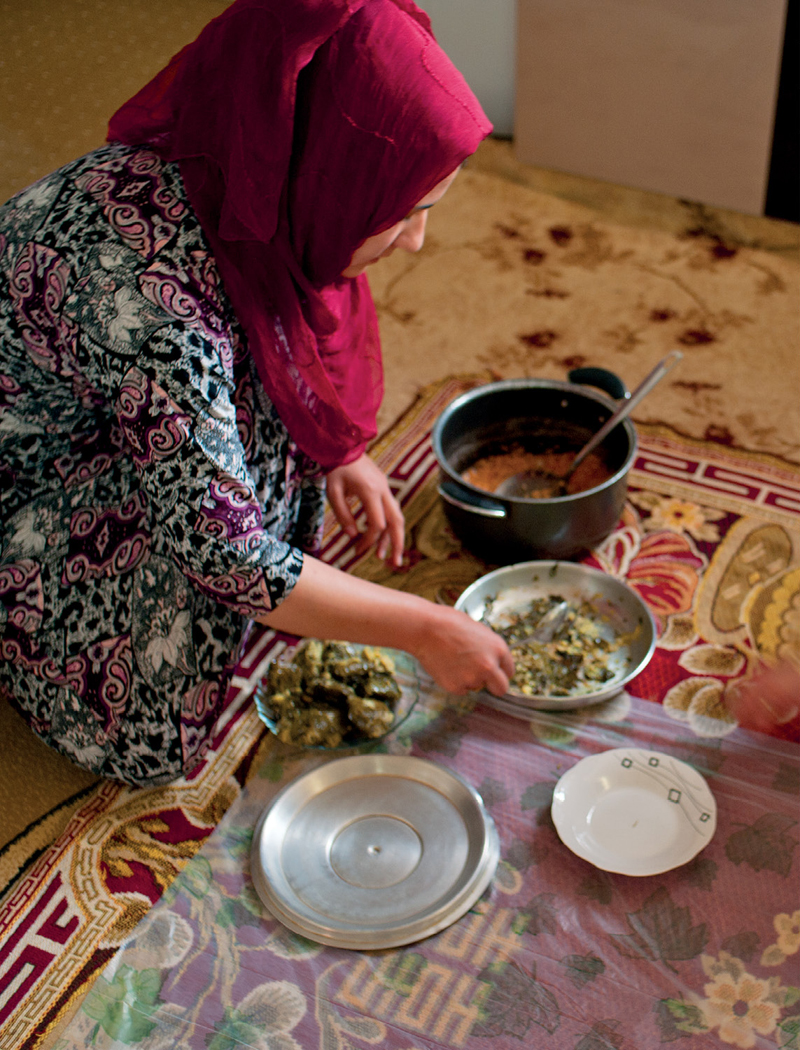

Halabja, Kurdistan—As in Persian tradition, living spaces in Kurdistan are thickly carpeted with several layers of rugs. Except in the modern houses of wealthier families, everything takes place on the floor, including eating. A sofreh, usually a large plastic sheet on which bowls and plates of food are placed, is set out on the rug. It’s an easy, convivial way to eat, and there’s no clutter of table and chairs taking up space in the living area.
The line between soups and stews is hard to draw in the Persian culinary world, where soups are often served as a main course, accompanied by cheese, bread, and generous plates of fresh herbs. And from the easy yogurt soups of the Caucasus to the hearty Persian soups called ash, soups here are outstanding.
The yogurt-based soups are delicious, sometimes loaded with fresh herbs (see Herbed Yogurt Soup, one of my favorites), sometimes thickened with potato and other vegetables (see Potato and Pumpkin Soup). There are also soups made with several kinds of beans or lentils and brightened with finely chopped greens. The most elaborate versions of this kind of soup are the thick green Persian ash dishes (see Pomegranate Ash with Meatballs, for example). Kurdish palpina, a soup of lentils and purslane (see recipe), is a simpler take on the ash idea.
And soup can also be a simple broth bathing a hearty centerpiece, as it is with the Azeri kofta (meatball) soups, which are really a main course disguised as a soup. I’ve included two versions, one from Tabriz, in Iran (see recipe), and the other from the Caucasus foothills in Azerbaijan (see recipe).
Cooks in the region often use tart fruits in soups, most often as a flavoring element to give acidity (see Farmstead Winter Soup) and occasionally as an appealing main ingredient (as in Dried Apricot Soup with Wheat Berries).
All through the Persian culinary region, yogurt and fresh cheese play an important role in daily meals. Here, in a simple country version of jajuk—the Armenian name for yogurt soup—yogurt is stirred into a smooth puree of cooked potato and pumpkin (or winter squash, or zucchini), seasoned with a little dried red chile, and finished with fresh herbs. This makes a great lunch or light supper with filled flatbreads, such as khachapuri (see recipe) or Half-Moon Hand Pies (see recipe), perhaps with a fresh salad on the side. Or serve it before a main course of lamb or turkey kebabs.
Serves 4 to 6
2 cups large cubes unpeeled pumpkin or winter squash, or substitute 3 cups chopped zucchini
2 medium potatoes, peeled and coarsely chopped (2½ to 3 cups)
1 teaspoon sea salt, or to taste
About ¼ teaspoon powdered dried red chiles or cayenne
½ cup finely chopped fresh flat-leaf parsley, dill, or mint, or substitute 2 teaspoons dried mint
1 cup plain full-fat yogurt, or as needed
Place the pumpkin or other squash and the potatoes in a pot, add about an inch of water, cover, and bring to a boil. Lower the heat to maintain a medium boil and cook until the vegetables are very soft, about 25 minutes for pumpkin and winter squash, less for zucchini.
Drain, reserve the liquid, and set aside to cool for 30 minutes.
Remove and discard the skin from the pumpkin or winter squash. Transfer the pumpkin or squash and potatoes to a food processor and process to a smooth slurry. Transfer to a bowl, add the salt, chiles or cayenne, and herbs and stir. Add the yogurt and stir to blend well. The texture will be thick yet pourable; thin it with a little of the cooking liquid or extra yogurt if you wish. Taste and adjust the seasoning if needed. Serve at room temperature.
Note: If you are making this in the summer and using zucchini, you might want to serve it chilled: Cover and refrigerate for an hour or so. If any liquid rises to the surface as it chills, just stir it back in before serving.
Photograph here
This soup was one of the most surprising dishes I came upon in my travels in the Caucasus. It was so simple and so perfect. I first had it in the old town of Sheki in northwestern Azerbaijan, made by a skilled home cook named Chamala. You’ll need to allow forty-five minutes to an hour for it to cook.
You can serve the soup warm or at room temperature. In the heat of summer, it is often served chilled. Leftovers have even better flavor. They always thicken, so just thin the leftover soup with a little water and then adjust the seasoning if necessary.
Serves 6 to 8
1 large or medium egg
½ cup Arborio or other short-grain rice, washed and drained
2 tablespoons all-purpose flour or 3 tablespoons rice flour
4 cups (32 ounces) plain full-fat yogurt
3 cups water
2 teaspoons sea salt, or to taste
4 cups finely chopped fresh herbs, ideally 1 cup each mint, coriander, flat-leaf parsley, and basil or watercress
About 2 teaspoons ground cassia (cinnamon)
Place the egg, rice, and flour in a wide heavy pot and whisk together. Add the yogurt, turn the heat to medium, and whisk until smooth. Add the water and whisk to incorporate it. Place a stainless steel spoon in the bottom of the pot and leave it there during the cooking. (This is a trick I learned from Chamala to prevent the mixture from sticking, and it works.) Bring to a simmer and cook until the rice is tender, about 45 minutes. The soup will have thickened and reduced a little.
Stir in the salt and chopped herbs. Let cook for another couple of minutes, until the herbs have softened a little, and remove from the heat. Taste and adjust the seasoning if necessary.
Transfer to a serving bowl or to individual bowls. Garnish the soup with cassia; Chamala sprinkled a thick line of cassia across the serving bowl of soup, then stirred it in once she had brought it to the table. The cassia pulls all the flavors together in a subtle, surprising way.
Armenians make a chilled yogurt soup that is quickly assembled on a hot day: Dilute plain full-fat yogurt with an equal volume of cold water. Season with a little salt, and add some or all of the following: chopped hard-boiled eggs, chopped cucumber, minced scallions, and/or coriander, parsley, and dill leaves. Serve immediately, with plenty of bread. And put out more of all of the flavorings you used, along with black pepper, so guests can dress their soup as they wish.
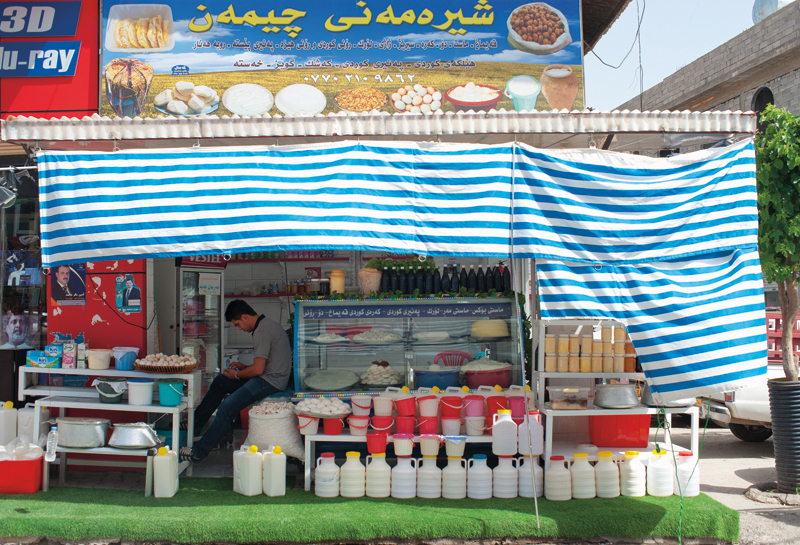
Sulaymaniyah, Kurdistan—A dairy shop in the bazaar sells yogurt, milk, and the yogurt drink ayran (see recipe); dried disks of the fermented whey product kashk (see Glossary); fresh cheeses and butter; and eggs.
Herbed Yogurt Soup (left; see recipe) and Dried Apricot Soup with Wheat Berries (right).
This warming country soup is from Javakheti in southern Georgia, where the majority population is Armenian. It’s made with tart dried apricots, emmer wheat, onion, potato (optional), and herbs. I love the way the flavors of cooked wheat and dried apricot dance together. A dollop of thick yogurt or a sprinkling of crumbled feta intensifies the tart-sweetness of the broth.
Serves 6
3 tablespoons sunflower or extra-virgin olive oil
1 cup thinly sliced onions or shallots
1 cup emmer wheat berries, washed well and drained
About 5 cups water or unsalted chicken broth; or 6 to 7 cups if using potatoes
1½ cups chopped tart dried apricots
1½ pounds waxy potatoes (about 4 medium), peeled and chopped into 1-inch cubes (optional)
1 teaspoon dried thyme
1 teaspoon dried mint, or to taste
1 to 2 teaspoons sea salt, to taste
Freshly ground black pepper
About ½ cup chopped mixed fresh herbs, such as tarragon, chervil, mint, basil, and lovage—use at least two
1 cup plain thick yogurt (see Glossary) or ½ pound feta or aged goat cheese
Flatbreads or toast
Place a wide heavy pot over medium-high heat. Add the oil, and when it’s hot, add the onions or shallots. Lower the heat to medium and cook, stirring occasionally, until the onions are translucent. Add the wheat berries and stir to coat with oil, then add 5 cups water or broth and bring to a boil. Add the dried apricots, lower the heat to maintain a strong simmer, and cook until the emmer is tender and the apricots have softened, about 30 minutes.
If using potatoes, add them along with another 1 to 2 cups water or broth, or as necessary to cover the potatoes. Add the thyme, mint, and 1 teaspoon salt, bring back to a boil, and cook until the potatoes are tender, 10 to 15 minutes. Taste and adjust the seasoning if necessary.
Ladle into bowls, grind on black pepper, and top each serving with a tablespoon or so of the chopped herbs. Serve hot, with one or both of the optional accompaniments if you like.
In northern Armenia, there’s a close cousin of this soup, called masrabur, made with rose hip liquid, and it’s one of the most hauntingly delicious soups I know. If you can buy organic rose hips at a farmers’ market or can gather them in the fall, then do. Boil them in water to cover until tender, then press the liquid through a sieve or food mill and discard the solids. Use the tart bright-tasting liquid as a base for this soup (store any extra in the freezer; see Note). Dilute 3 cups of it with an equal amount of water, bring to a boil in a large saucepan, and add 1 teaspoon salt and ½ cup emmer wheat berries. Boil until the berries are starting to soften. Add 1½ cups chopped dried apricots and 1 cup chopped onion and cook at a low boil until the wheat berries are tender, about 30 minutes. Stir in 2 teaspoons dried mint and another 1 teaspoon salt, then whisk in ½ cup sifted flour (or, more traditionally, small scraps of dried flatbread) and cook for 5 minutes more to thicken. Serve hot or at room temperature, with cheese, fresh herbs, and bread.
Note: Rose hip liquid is also used by Armenian cooks to flavor the water for cooking dolmas (stuffed vegetables), especially stuffed cabbage leaves (see recipe).
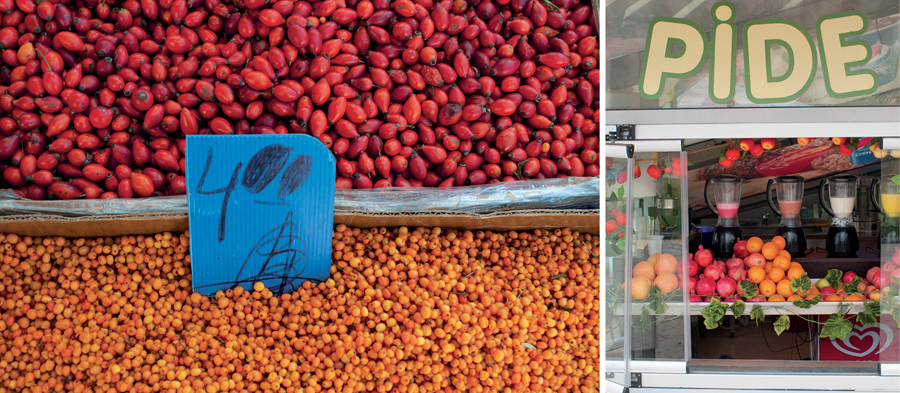
Left: Tbilisi, Georgia—Wild-gathered autumn bounty at a market. At top are rose hips, and below, sea buckthorn berries (see Glossary).
Right: Baku, Azerbaijan—A snack bar by the old city wall in central Baku sells pide, the Azeri (and Turkish) word for flatbread topped with ground meat or other flavors, along with fresh-made juices and smoothies.
Springtime in Kurdistan means palpina, a thick soup of lentils (nisik in Kurdish) and chopped purslane. I love it.
Purslane is a wild green with small, thick, succulent leaves and reddish stems (see Glossary). It’s often treated as a weed in North America, but it’s a much-valued vegetable from Iran to the Caucasus, as well as in the eastern Mediterranean region, where it’s used raw in salads. Some farmers are starting to cultivate it in North America, so it should soon become easier to find.
Though it’s not traditional, I like to drizzle a little Mint Oil (see recipe) or olive oil over each serving.
Serves 8
1 cup brown lentils, rinsed and picked over
½ cup minced onion
½ cup Arborio or other short-grain rice, washed and drained
7 to 8 cups water or unsalted light chicken or vegetable broth, or as needed
3 tablespoons tomato paste
1 teaspoon ground cumin
¼ teaspoon turmeric
2 to 3 teaspoons sea salt, to taste
3½ packed cups finely chopped purslane leaves and stems
Freshly ground black pepper
Flatbreads
Fresh goat’s- or sheep’s-milk cheese
A generous Herb Plate (see recipe): tarragon, chervil, mint, lovage, and scallion greens (use two or more)
Place the lentils, onion, and rice in a large pot, add 7 cups of water or broth, and bring to a vigorous boil. Skim off any foam, cover, reduce the heat to maintain a low boil, and cook until the lentils are tender, 35 to 45 minutes; add more water or broth if needed.
Stir in the tomato paste, cumin, turmeric, and 2 teaspoons salt, then add the purslane and stir thoroughly. Cook until the purslane is very soft and flavors have blended, about 30 minutes; add more liquid if the soup gets too thick. Taste and adjust the seasoning if needed. Ladle into individual bowls and sprinkle with black pepper. Put out the flatbreads, cheese, and herb plate, and invite your guests to sprinkle a little cheese onto their soup.
I’d read about the huge meatballs of Tabriz, so as soon as I arrived there, I hustled out to a local restaurant in search of kofta tabrizi. The meatball that came in a light tomato broth was about three inches across. It was tender, studded with rice and tart barberries, and stuffed with more barberries, as well as sour plums and hard-cooked eggs. The tart fruits intensified the rich flavor of the meat. Each mouthful was a complex pleasure.
Serves 8
3 medium onions, coarsely chopped
2 pounds ground lamb or beef (ideally 25% fat)
1 tablespoon dried mint
½ teaspoon ground cassia (cinnamon)
2 teaspoons sea salt
1 teaspoon freshly ground black pepper
1 cup jasmine or other medium- or short-grain rice, washed and drained
1¼ cups dried barberries (see Glossary), soaked for 30 minutes in cold water and drained
4 hard-boiled eggs, peeled and coarsely chopped
10 dried sour plums or apricots, well washed (if the plums or apricots are very dried out, soak in warm water for 30 minutes and drain)
1 medium onion
2 tablespoons sunflower or extra-virgin olive oil
¼ teaspoon turmeric
3 medium tomatoes, peeled and minced
About 4 cups water
2 teaspoons sea salt, or to taste
Generous grinding of black pepper
½ cup chopped fresh flat-leaf parsley (optional)
To make the meatballs, put the onions in a food processor and process, pulsing, to a soft mush. Add the meat, dried mint, cassia, salt, and pepper and process to blend well. Turn out into a bowl, add the rice and 1 cup of the barberries, and mix and knead with your hands, squeezing the mixture through your fingers and blending well. Cover and refrigerate for at least an hour, or overnight.
To shape the meatballs, divide both the meat and the hard-cooked eggs into 10 equal portions. Using wet hands, shape one portion of meat into a firm ball. Hold the ball in one hand and use a spoon to scoop out a portion of one side. Set the scooped meat aside and press your thumb into the center of the ball to make a rounded hollow. Place 1 plum or apricot, 1 teaspoon barberries, and one portion of hard-cooked egg in the hollow. Replace the meat you removed, pressing it into place, and shape the ball again between your wet palms, pressing firmly so it holds together. Place on a lightly oiled plate or small baking sheet. Repeat with the remaining meat and filling. Cover the meatballs and refrigerate. The meatballs can be made up to 2 days ahead.
To make the broth, about an hour or so before serving, grate the onion on a box grater.
Place a wide heavy pot over medium heat and add the oil, then add the turmeric and onion and cook, stirring until the onion is translucent. Add the tomatoes, lower the heat, and simmer for a few minutes. Add the water. The liquid should be about 3 inches deep; add more water if necessary. Bring to a boil and add the salt and pepper.
Slip the meatballs into the boiling soup. Bring back to a boil, then lower the heat to maintain a strong simmer, partially cover, and cook, shaking the pot occasionally to move the meatballs around, for 40 minutes, or until the meatballs are cooked through.
Serve the meatballs bathed in the broth, and sprinkle on the parsley if you wish.
Left: Sheki, Azerbaijan—Autumn market combo: fresh yogurt, barberries, and ripe pears.
Right: Lahich, Azerbaijan—A few kofta in Jairan’s kitchen (see Lahich-Style Kofta Soup), ready to be cooked. The word kofta—sometimes transcribed kufta—comes from the Persian word for “pounded,” because the meat used for the meatballs is ground or pounded almost to a paste.
I learned this version of Azeri kofta from a woman named Jairan, in Lahich. She prefers not to use turmeric, but many people do use it. I like the color it gives. The soup is also colored and flavored by a little tomato, a nice acid balance to the meat. The meatballs are flavored with herbs (dried mint in winter or fresh coriander in warmer months) and stuffed with dried apricots.
With chickpeas and potatoes giving it body, the soup is heartier than the broth I had with kofta in Tabriz, making the dish a filling meal-in-one. Any leftovers are delicious, reheated gently.
Serves 8 to 10
3 medium onions, coarsely chopped
2 pounds ground lamb or beef (20 to 25% fat)
1 teaspoon ground ginger
½ teaspoon ground cassia (cinnamon)
2 teaspoons sea salt
1 teaspoon freshly ground black pepper
1 cup jasmine or other medium- or short-grain rice, washed and drained
2 teaspoons dried mint or ½ cup minced fresh coriander
10 dried apricots, well washed (if the apricots are very dried out, soak in warm water for 30 minutes and drain)
1 medium onion
2 tablespoons sunflower or extra-virgin olive oil
¼ teaspoon turmeric
1 large or 2 small Roma (plum) or other fleshy tomatoes, peeled and minced
4 cups water
1 cup cooked or canned chickpeas (see The Precooked Beans Habit)
10 medium waxy potatoes (about 2 pounds), peeled and halved, or 4 or 5 larger potatoes, peeled and cut into large cubes
2 teaspoons sea salt, or to taste
Generous grinding of black pepper
1 to 2 teaspoons dried mint (optional)
To make the meatballs, put the onions in a food processor and process, pulsing, to a soft mush. Add the meat, ginger, cassia, salt, and pepper and process to blend well. Turn out into a bowl, add the rice and mint or coriander, and mix and knead with your hands, squeezing the mixture through your fingers. You want a very even texture. Cover and refrigerate for at least 1 hour, preferably 6 hours, before using.
To make the soup, about an hour and a half before serving, grate the onion on a box grater.
Heat the oil in a wide heavy pot over medium heat. Toss in the turmeric and onion, stir in the tomatoes, lower the heat to medium-low, and cook for 2 to 3 minutes. Add the water and bring to a boil, then lower the heat to maintain a steady simmer.
If using chickpeas you cooked, rub them between your palms to loosen their outer skins; discard the skins. If using canned chickpeas, rinse them in several changes of water. Add the chickpeas to the pot and cook for 20 minutes.
Meanwhile, shape the meatballs: Divide the meat mixture into 10 equal portions. Wet your hands, pick up one portion, and shape it into a firm ball. Holding the ball in one hand, make a hole in it with the index finger of your other hand and push an apricot into the hole. Smooth the meat back over the hole to seal it well and shape and firm the ball again. Set aside on a lightly oiled plate (see photo). Repeat with the remaining meat and apricots.
Add the meatballs, potatoes, salt, and pepper to the broth and bring to a steady low boil. Partially cover the pot and cook for 30 minutes, or until the meatballs are cooked through. Taste the soup and adjust the seasoning if necessary.
Divide the meatballs and soup among individual bowls and sprinkle on the dried mint if you wish. Serve hot.
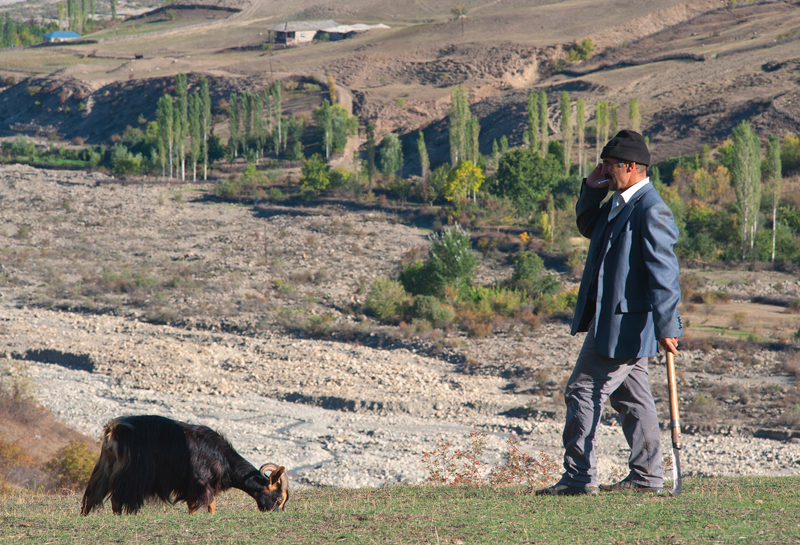
Lahich, Azerbaijan—A shepherd on his cell phone in the big Caucasus-foothills landscape outside Lahich (see Feasting in a Garden of Eden). His flock of sheep and goats drifted along the hillside, while his dog kept a close eye on them.
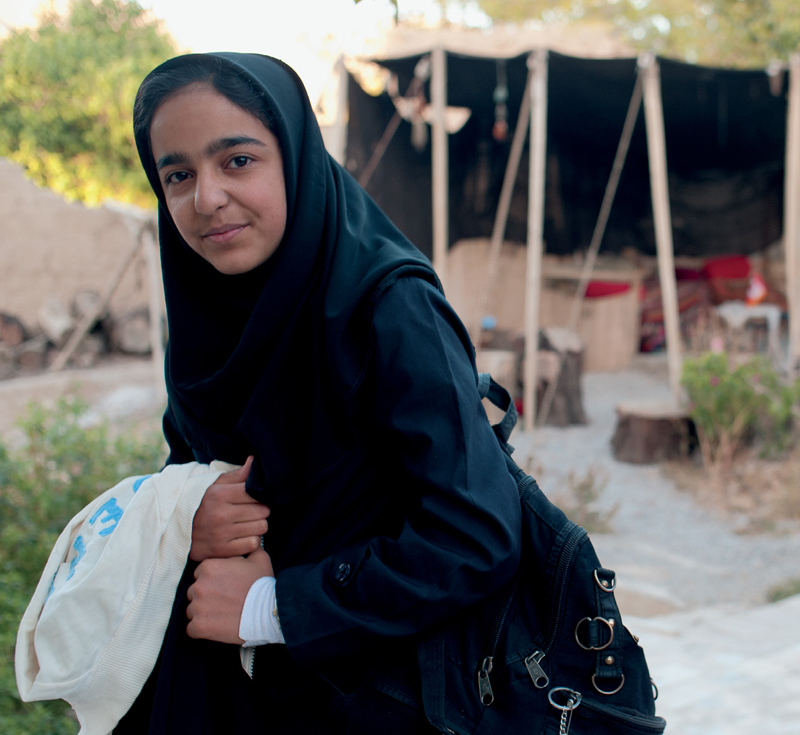
Between Shiraz and Yazd in southern Iran—Heading off to school, at age fourteen, covered in black from head to toe.
When I stayed with a family on a farm three hours’ drive east of Shiraz, I watched the two daughters, both lively and intelligent, get ready for school in the morning. Niloufer, eleven, wore pants, a long manteau top, and a kind of pink wimple of stretchy knit material that framed her face and covered her hair and neck completely. Over that she put on a looser head covering, a kind of scarf. The older daughter, aged fourteen, was entirely in black, as the school required of girls her age: pants, manteau, and scarf over the hair, and, on top of all that, a black chador to the ground. Her liveliness was drowned in all the black.
As a female visitor in Iran, I had to follow the rules and cover my head, my neck, and my arms and legs. And in any case, I didn’t want to give offense. Or that’s how I felt at first. But once I realized that most people disliked the rules, though I still complied, I was no longer so worried about offending custom. I was instead aware that I could be chided for having my scarf tied so ineptly that too much hair was exposed.
Even unworried, I found myself after my first few days in Iran taking on the habits of the women there: You reach up and feel the top of your head to check whether your scarf has slipped back. Then you run your fingers along the edge of the scarf, where it meets your face, to check that no hair has strayed forward and that the edges are even. It becomes a tic, endlessly repeated. A time lapse of women on a bus or at a restaurant or in a car—or in a classroom, I suppose, too—would show a pattern of check, adjust, recheck, readjust, going on all over the female landscape.
Extraordinary. And taken for granted by the women of Iran. They have to take it for granted, or it would surely drive them around the bend. In any case, they have more important things to worry about: They are doctors and teachers and filmmakers, mothers and grandmothers, sweepers and cooks, secretaries and managers.
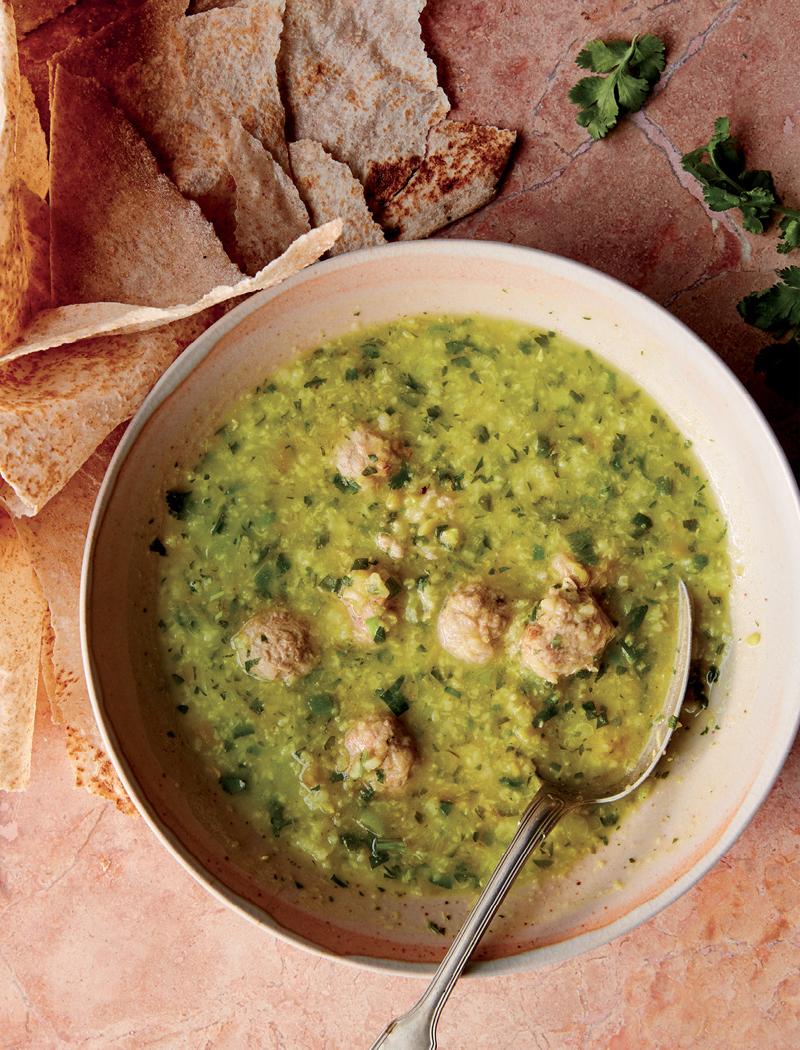
Ash is at the heart of Persian home cooking, a category of slow-cooked sustaining soups that are welcoming, subtle, and rewarding for cooks and eaters alike. The soups are also flexible: You can make substitutions, as long as they stay within the feel of the original.
This ash is an inviting blend of legumes and rice, flavored with little lamb meatballs. A crowd-pleaser. Like most ash recipes, this one looks long, but please don’t be dismayed. Yes, it takes some time to cook, but it’s a carefree kind of thing to make: Start it on a weekend afternoon and then set it aside until shortly before you want to serve it. Or make it a day ahead, and reheat it to serve. Just make sure it comes to the table hot.
Serves 6
¼ cup sunflower or extra-virgin olive oil
1 onion, sliced
½ teaspoon ground cassia (cinnamon)
½ teaspoon turmeric
¾ cup short-grain rice or broken jasmine or basmati rice (see Note), washed and drained
¾ cup dried split peas, soaked in water for an hour (or as long as 12 hours) and drained
8 to 10 cups water, or as needed
¼ pound scallions, trimmed and finely chopped
2 bunches flat-leaf parsley, leaves and tender stems, finely chopped (about 2 cups)
2 bunches coriander, leaves and stems, finely chopped (about 2 cups)
1 bunch mint, leaves finely chopped (about 1 cup)
1½ tablespoons sea salt, or to taste
4 to 6 tablespoons pomegranate molasses, to taste
1 onion, grated
½ pound ground lamb
1 teaspoon sea salt
¼ teaspoon freshly ground black pepper
About ¼ cup sunflower or extra-virgin olive oil
2 tablespoons dried mint
1 cup thinly sliced onion
To make the soup, place the oil in a large heavy pot over medium-high heat, toss in the onion, cassia, and turmeric, and cook until the onion is translucent, 4 to 5 minutes. Add the rice, drained split peas, and 8 cups water, raise the heat, and bring to a boil, then lower the heat to maintain a strong simmer and cook for 1 to 1½ hours, or until the split peas are tender.
While the soup is cooking, make the meatball mixture: Mix the onion thoroughly with the lamb. Mix in the salt and pepper. Set aside, covered, in the refrigerator.
Add the scallions, parsley, coriander, and mint to the soup and simmer for 30 minutes. Add another cup or two of water to thin it, as you wish, and bring back to a strong simmer. Add the salt and 4 tablespoons pomegranate molasses and stir. Taste and add a little more pomegranate molasses if you like.
Make the meatballs about 15 minutes before you want to serve: Scoop up about a heaped teaspoon of the meat mixture for each and roll it into a ball between your wet palms, then drop it into the soup. Let the soup continue to simmer while you make the toppings.
Pour 2 tablespoons of the oil into a small skillet and heat over medium-high heat. Toss in the dried mint and immediately remove from the heat; it will fizz up a little. Set aside in a small bowl.
Heat the remaining 2 tablespoons oil in the skillet over high or medium-high heat, add the sliced onion, and fry until starting to brown and crisp, about 6 minutes. Set aside on a plate.
Ladle the hot soup into individual bowls, making sure to serve several meatballs in each, and top with a drizzle of mint oil, and with a sprinkling of fried onions if you wish.
Note: Short-grain rice or broken rice will break down more easily than long-grain rice as it cooks, and the starch from the rice helps thicken the soup.
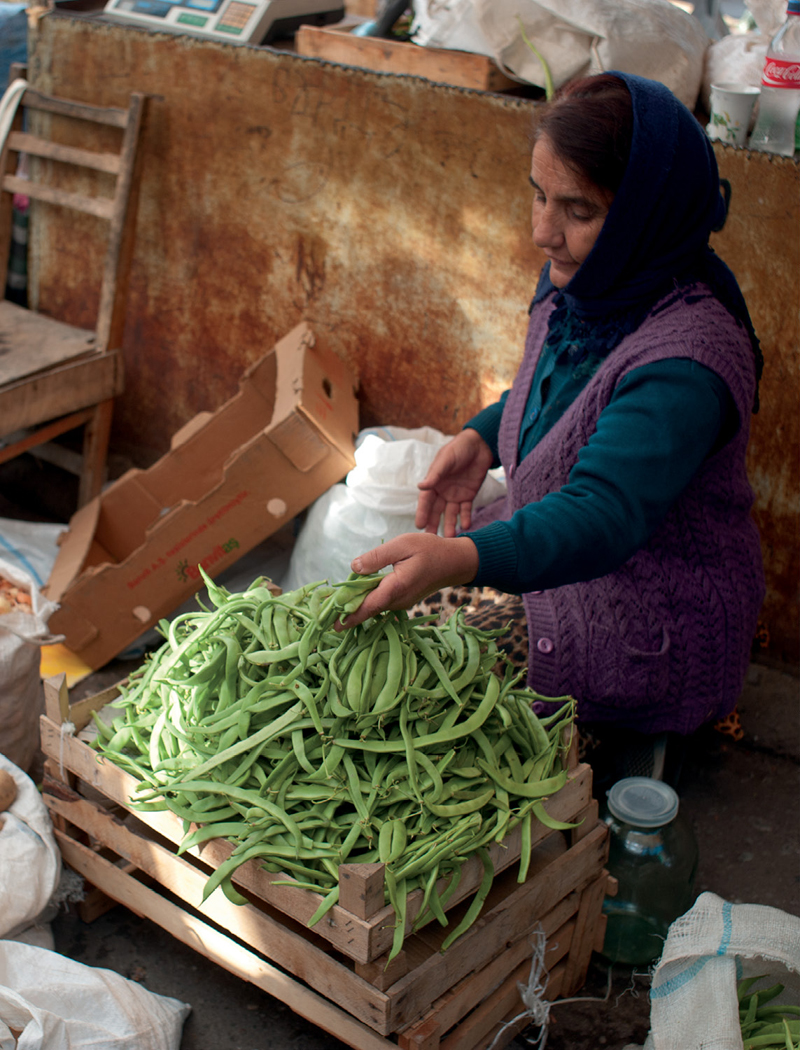
Sheki, Azerbaijan—A market vendor stacking her fresh beans.
I spent a couple of days at a small farm run by Afsar and her husband, Abbas, in a fertile valley northeast of Shiraz. Afsar’s storage room was loaded with treasures: jars of verjuice and pomegranate molasses, as well as distilled flower essences, fruit jams, raisins, dried mint and other herbs, and more.
Verjuice, from the French verjus, is the tart-tasting juice from unripe grapes. The vines are pruned partway through the growing season to ensure better grapes on the bunches that remain. The unripe grapes on the prunings don’t go to waste—they are pressed for their juice. It’s a common practice, not just in wine-producing countries such as France, but also in Iran. If you don’t have verjuice, you can substitute wine vinegar or lemon juice to give the distinctive tart accent that characterizes this satisfying soup.
You can use precooked beans (see The Precooked Beans Habit) or drained and rinsed canned beans, or you can start from scratch.
Although Afsar made her ash without meat, you can include a little ground meat as a topping (gheimeh in Persian) if you wish, as set out below. She didn’t use any fresh greens either, to show me the way she makes it in winter. If you do have fresh greens such as spinach or kale, finely chop about 4 cups and add them once the beans are cooked.
Serves 4 to 6
½ cup dried whole mung beans or black-eyed peas, or about 1½ cups cooked beans, with their cooking liquid, or 2 cups canned
1 cup dried split peas, or 2½ to 3 cups cooked split peas, with some of their cooking liquid, or 3 cups canned
8 cups water, or as needed; or about 3 cups if starting with cooked or canned beans
½ cup short-grain or broken rice, washed and drained
¼ cup butter-ghee or sunflower oil
½ cup minced onion
3 tablespoons dried mint
2 teaspoons sea salt, or to taste
2 to 3 tablespoons verjuice, or substitute white wine vinegar or fresh lemon juice
Generous grinding of black pepper
2 tablespoons sunflower or vegetable oil
1 cup minced onion
¼ pound (½ packed cup) ground lamb or beef
2 tablespoons split peas, washed and drained
About 1½ cups water
½ teaspoon sea salt
Generous grinding of black pepper
About 1 tablespoon tomato paste
If you’re starting with dried beans and peas, rinse them and place in a large pot with 8 cups water, or enough to cover by 2 inches or so. Bring to a boil, add the rice, partially cover, and cook at a strong boil until the beans are softened, 1 to 1½ hours; check occasionally to make sure the pan is not running dry and top up with another cup or two of water if needed.
Meanwhile, if you want to include the meat topping, heat the oil in a medium skillet over medium-high heat, toss in the onion, and cook until translucent, about 4 minutes. Add the meat and split peas and cook, stirring, until all the meat has changed color. Add enough water to cover by ½ inch and simmer, partially covered, for 15 minutes, or until the split peas have softened; if the pan starts to run dry, add a little more water. Add the salt, pepper, and 1 tablespoon tomato paste and stir in, then cook over low heat for another 10 minutes or so. Taste and add a little more tomato paste if you wish. The mixture should be fairly dry. Transfer to a small bowl. The topping is served at room temperature.
If using precooked or canned beans, place in a pot with about 3 cups water and the rice and bring to a boil. Simmer, partly covered, for 15 minutes.
To prepare the flavorings, heat a heavy wide skillet over medium-high heat, add 1 tablespoon of the ghee or oil, toss in the onion, and cook, stirring, until it is just translucent, about 4 minutes. Add the onion to the beans and stir.
Put the skillet back on the heat, add the remaining 3 tablespoons ghee or oil, and toss in the dried mint. Stir briefly and add to the beans, along with the salt. Stir in 2 tablespoons verjuice or vinegar or lemon juice; taste and add more tartness if you wish. (The soup and topping can be prepared ahead to this point and set aside until just before you wish to serve. Refrigerate if the wait will be longer than 2 hours.)
Bring the soup back to a boil (add extra water to thin it if needed), then lower the heat and simmer for a few minutes. Taste and adjust the seasoning and tartness if you wish. Stir in the black pepper.
To serve, ladle the soup into individual bowls and sprinkle on some topping, if using.
Cooks all over Iran make ash-e-reshteh, a slow-simmered dish of beans, greens, and fresh noodles—reshteh—topped with mint oil and other flavors. It’s one of the dishes everyone eats at Nou-Roz (see Zoroaster’s Legacy).
I include instructions for making the noodles, but you can substitute dried pasta. Traditionally the noodles are cooked with the beans, but I find it easier to cook them separately in boiling water until nearly done, then add them to the soup.
Serves 6
2½ cups all-purpose flour, plus extra for surfaces
1 teaspoon sea salt, plus extra for boiling
About 1 cup water
1 cup mixed dried beans and lentils, such as ½ cup navy beans or black-eyed peas, ¼ cup fava beans, and ¼ cup lentils
6 cups water, or as needed
½ pound spinach, finely chopped (4 packed cups)
1 cup packed chopped fresh flat-leaf parsley
½ cup finely chopped fresh scallion greens or Chinese chives
1 tablespoon sea salt, or to taste
½ teaspoon freshly ground black pepper
1 tablespoon Mint Oil (see recipe)
¼ cup sunflower or extra-virgin olive oil
¼ teaspoon turmeric
1 cup sliced onion
About ½ cup kashk (see Note and Glossary) or thick sour cream (optional)
2 tablespoons Mint Oil (see recipe)
About ½ cup plain thick yogurt (see Glossary; optional)
2 tablespoons Saffron Water (see recipe; optional)
If making fresh noodles, place the flour and salt in a bowl, add 1 cup water, and stir until a dough forms. Alternatively, place the flour and salt in a food processor, add the water, and pulse until a dough forms. Turn the dough out onto a well-floured surface and knead until smooth and elastic, incorporating flour as necessary so that it is firm and no longer sticky, 3 to 4 minutes. Set aside, covered with plastic wrap, to rest for at least an hour.
Rinse the beans and lentils in several changes of water and put them in a heavy pot with the water. Bring to a vigorous boil, then lower the heat to maintain a medium boil and cook, partially covered, for 1 hour, or until nearly tender.
Meanwhile, if making fresh noodles, cut the dough into quarters. Place one piece on a floured surface, flatten it with lightly floured hands, and use a rolling pin to roll it out to a thin (less than ¼-inch-thick) rectangle or oval. Dust both sides of the dough with flour, cut it into long strips less than ¼ inch wide, and hang over the back of a chair. Repeat with the remaining dough.
(If using dried kashk, soak it now; see Note.)
Add the spinach, herbs, salt, and pepper to the beans and stir. Add more water if necessary; you want a very soupy texture. Bring back to a boil, then reduce the heat to very low and simmer for 15 minutes.
Make the onion topping: Heat the oil in a large heavy skillet over medium-high heat. Toss in the turmeric and the sliced onion and cook over medium heat, stirring occasionally, until the onion is translucent and starting to crisp at the edges. Lift out of the oil with a slotted spoon and set aside.
About 20 minutes before serving, bring a large pot of water to a rolling boil. Add 2 tablespoons salt, bring back to a boil, and toss in the fresh noodles or dried pasta. Cook until just barely cooked through, about 4 minutes for fresh noodles or about 12 minutes for dried. Drain the noodles, add to the pot of beans and greens, folding them in gently, and remove from the heat.
Add the tablespoon of mint oil to the pot of beans. Serve the soup hot in large deep bowls. Stir about 1 tablespoon kashk or sour cream into each serving, if using, top with some of the reserved fried onions, and drizzle on about a teaspoon of mint oil. If using the yogurt and saffron water, dollop about 1 tablespoon yogurt onto each serving and top with a drizzle of saffron water. Serve immediately.
Note on Kashk: If using disks or balls of dried kashk, measure out about ¼ cup of them and soak in ½ cup lukewarm water for 30 minutes or so. Once they have softened completely, whiz the mixture briefly in a blender. If using kashk paste, put ⅓ cup paste in a small bowl, add 2 tablespoons water, and whisk or stir until smooth.